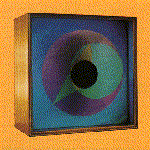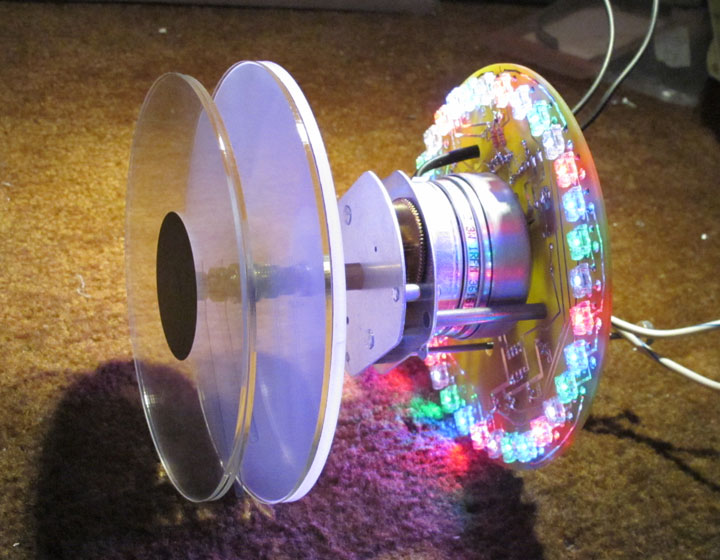We repair all Chrono-Art clocks.
Links about the older Aurora & Prisma clocks (by Kirsch-Hamilton)
Or for other repair information --- just keep scrolling down.
Parts ordering information on all clocks
The –– "Dot Clocks" –– ChronoArt's first clocks:
|
About 2,000 made |
About 200 made |
|
|
|
|
|
|
| 23.5" X 20" wall art clock |
|
|
|
|
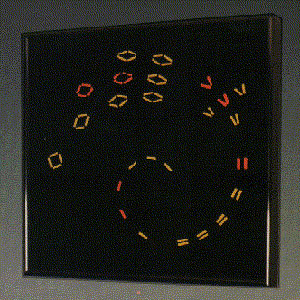 |
||
|
Sold for $295 |
Sold for $395 |
Sold for $195 |
Call for repair information on these 3 clocks.
TIME CAPSULE (1996-1999)
About 300 made. Sold for $150.
Time Capsule Instructions.pdf
Call for repair information on this clock.
There were three U.S. versions of this clock. The Serial Prefix on the bottom of the clock indicates the version. There was also a version made in China.
Audocron Chime Clock Instructions in pdf
Oldest "A" Version "N" Version "LX" Version Newest
Sometimes repairs where done and new electronics were installed but the serial number prefix was not changed on the bottom. Because of this you may want to download yours and the newer versions. All three versions set the time differently. The two oldest are large files.
Lumina, ChronoArt's first polarized light clock (1993-1996)
About 500 made. Sold for $175.
Call for repair information on this clock.
We repaired the Kirsch-Hamilton clocks from 1991 until August 13, 2021
All repairs are now done by Angie at AP Clocks. She also makes all the new ones.
Go to Angie's webpages AP Clocks, or call 707 694-7719 or email apclocks@gmail.com
|
|
|
First let's talk Aurora, scroll down for the Prisma.
The information below is out of date, but still has value.
A little Aurora history: The first were made by Rathcon and called the Spectrum (guess, about 6,000 were made). Then came the regular Aurora that the vast majority of you owned. About 41,000 Auroras were made over 20 years. For the first few years Kirsch-Hamilton had them made by Newton Plastics (NPC) in Newton,MA. Then the name (Kirsch-Hamilton) was sold to Hampton Haddon a marketing company. The Auroras were manufactured by Newton Plastics for Hampton Haddon. Next, in the late 80's, Hampton Haddon had a version made in Japan that they imported (guess 1,000 were made). A lot of customers acquired the Japanese version when they sent in their original Aurora for repair and it was exchanged for the Japanese version by Hampton Haddon. Hampton Haddon abandoned the clock around 1991. Then in 1993 we at ChronoArt started manufacturing Luminas (a polarized light clock, see above) and then a year later started also manufacturing new Auroras and repairing the old ones. Our first Auroras were made of brass that was either nickel-chrome plated, or that plus 24k gold plate. These were the most polished Aurora ever made.
The Rathcon versions of the Aurora (called Spectrum) can only be repaired by completely gutting the clock an putting in all new Aurora parts.
The Spectrum and original Aurora both used incandescent lamp/s that caused the clock to run very hot and shortened the life of the motor and the filters.
The Japanese version of the Auroras had the most beautiful colors and the nicest case; the aluminum was bright dipped and then clear anodized so it kept its shine and was hard to scratch. Sadly the Japanese clock motors had plastic gears that where easy to damage when setting the time, and those gears wore out much sooner than the metal geared motors made by Hansen that were in the original clocks. The Japanese version had the good idea, at the time, of using cool running, cold cathode fluorescent lamps, but they then made the mistake of putting these lamps too near the rear polarizer which damaged it and cause dark streaks on the rear filter, and then added to the problem by gluing in the rear polarizer, making it impossible to replace. Plus they used a motor with plastic gears that were not heavy duty enough to last. So like the Rathcon version once the motor goes the insides of the clocks must be completely replaced with the original U.S. version parts.
The regular Auroras, made by Newton Plastics, that most of you have were made out of polished, but not anodized aluminum. There is an advantage to the aluminum just being polished. If you scratch the case, the scratch can be polished out. With the Japanese version they were very hard to scratch but if scratched there is no way to fix a scratch.
For about the first 6 years that ChronoArt made the Auroras they were made out of brass that was nickel plated. These were the prettiest cases of all, but very expensive. Later because of rising cost we went back to the original polished aluminum case for new Auroras. Several batches of these cases were made by the Newton Plastics, the people who made them in the 1970s.
With Auroras the repair process goes like this:
Send in your clock with a note describing the problems (no need to call for permission, just send it). But of course it you have questions, call me (Barry Gamble). When we receive your clock we will call you and describe the choices and cost of each. Most customers want a complete rebuild. Prices for Aurora are in one of the following areas (approximately):
$60 to $105 for minimal lighting trouble. The reason for the price range is challenges of getting the lamp socket out.
$165 to change the clock motor.
$280 for motor and filters (this leaves in the old hot running tail light and puts in a Japanese face filter).
$345 includes the latest 7/19 version of the LED (cool running with many more colors, lighting technology.
These prices are a close approximation and include shipping labor and parts. (Prices as of December 2019)
The Spectrum and the Japanese Auroras are $25-30 more.
After you and I chat you can choose the level of repair you want, and send a check or just give us your credit card information. Nothing is put on your credit card until the day we ship. We also send you 2 emails, one with tracking information and one with your receipt that day.
The average repair time is 3-4 days or 4-6 weeks during the Christmas rush.
Warranty depends on the work done. When you have the compete ($345ish) job (85% of you do the complete job) with the LED lighting, then it runs cooler and is more reliable and we have less trouble so there is a one year warranty on parts and labor. If you leave the hot lamp inside (do not convert to LEDs) the warranty is 12 months on parts but 90 days on labor. If you just do a motor repair the warranty is one year on the motor and 90 days on labor. If you just do something simple with the lighting the warranty is 90 days on parts and labor. We only warranty the parts we worked on. For example if you just change the filters then there is no warranty on the clock motor or light system.
Pack the Aurora with a couple of inches of bubble pack on all sides, use a sturdy box, and ship your clock to: Address
The Aurora base.
The Aurora original base had a plastic piece that covered the bottom so you did not see the wires inside. It was made out of a very thin black plastic that frequently has fallen apart over the years. It also had no feet on it so it could scratch the surface you sat the clock on. This was only a problem with customer with fine lacquered desks, counter, or bar tops, etc. Our new clocks have a much more substantial base of 1/4 inch thick acrylic with a routed flame polished edge and rubber feet giving the clock a more finished appearance. The base plugs are $12. We rarely include the base plug in the quotation, so if you want it, please call it to our attention. It is pictured below.
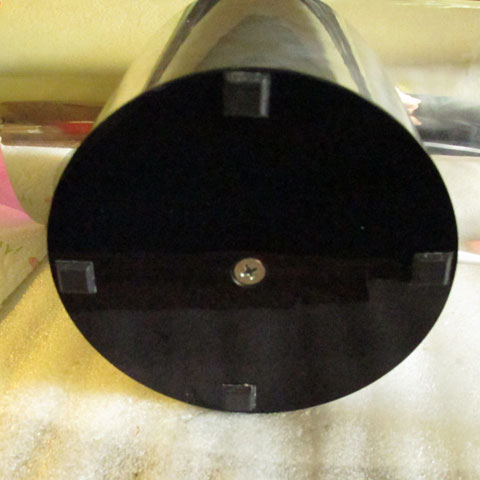
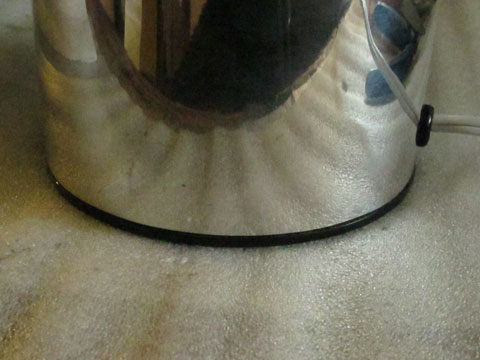
Aurora LED Light Conversion
I believe the video is an LED clock we repaired.
The Problem: The original Aurora clock has had a design problem that most of you are very aware of -- it ran very hot. Most of the heat come from the incandescent lamp that lit it up. The heat discolors the expensive filters that create the wonderful colors and shortens the motors life. Every 12 years many of you have been sending in the clock for reconditioning. An expensive nuisance, plus it looked bad for the last few years.
The Solution: The Aurora can be modified to use the very long life, cool running LEDs. The modification costs $90, when the clock is already here for other work.
The other advantages:
- More colors, both saturated and pastels. There is a microprocessor inside slowly changing which colors are being featured -- see photos below.
- Colors that do not repeat exactly twice per minute like the original clock. The action of the rotating quarter wave retarder (second hand disk) and the microprocessor are intentionally not synchronized giving you a much more interesting clock in the way it sequences through colors.
- A button inside that you can used to brighten the clock up for an office, or dim it down for a bedroom, or set it to minimum brightness for when you go on vacation.
- No lamps to change. After about 15 years it will get a little dimmer and after 20 years the motor will probably fail and you can send it in and have both changed.
For your reference 85% of the customers that send in the clocks for repair have the LED conversion installed.
Attention: Some of you are concerned about the LEDs making a change in how the colors are generated, thus affecting the purity of the design. 80% of the color changing is still from the filters; the LEDs just add another 20%. If the filters were not there then everything, the hour hand, minute hand, second hand disk would all be the same color. The LEDs are more of an enhancement to the polarizer technology, but certainly no replacement. It is still the polarized light technology that makes the Auroras wonderful and suprising.
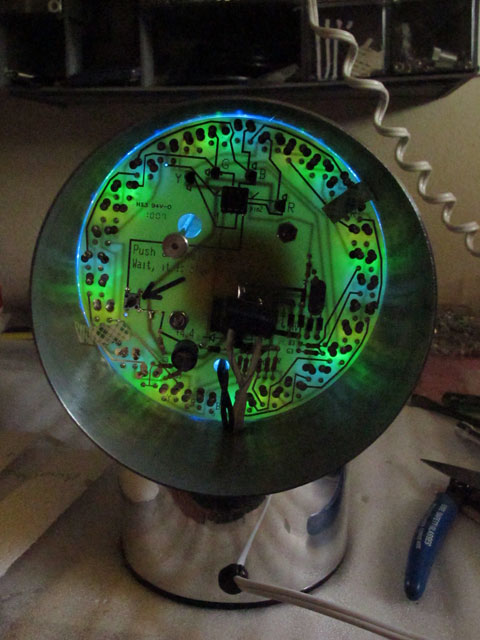
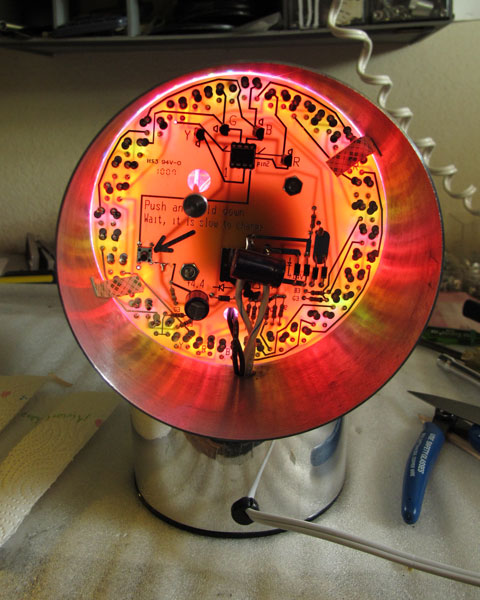
The above pictures are of an old version of the LED lamp electronics.
Colors accentuated by microprocessor slowly changing what colors dominate.
Red, blue, green and white LEDs turned on. Eight LEDs of each color.
New (8/21/21) update to Prisma Servicing Discussion:
First the easy things: The Motor.
Give me a call if the motor has stopped and you are a little mechanically adept I can probably just send you a motor and save you $40 in labor and $38 in shipping each way. A question I will ask when you call, "How hard is it to turn the setting knob?" Your answer will affect what we (you and I) can do.
The clocks have two lamps. If the lights keep going out, then its time to install new lamps. They are easy to install. Just remove the two screw on the back and pull the back off. The replacement lamps you can buy today do not last a long time, just 10-12 months. You can blame the EPA, they want less mercury in the lamps. You can buy them at Lowe's or Home Depot, but their price has gotten ridiculous – $8 to $10 each. You can get 6 of them from us at ChronoArt for $29, plus about $9 shipping. Just send in a check, add 7.25% for sales tax if you are in California or call with your credit card, 1-707-795-1895, M-F 8-5PM, Pacific Time (No Weekends Please).
ChronoArt Inc.
9175 Poplar Ave.
Cotati, CA 94931
Now information about the lighting history and the new LED lamp card.
First, I sell the fluorescent lamps for the Prisma. They are 6 for $25 plus shipping. Call M-F 8-5PM Pacific Time, No Weekends Please, 1 707 795-1895. Note that not all lamps brands will work in these clocks because this clock has the 2 lamps wired in series like and old fashion Christmas tree lamp. Many lamps are not make to work with 2 in series. A real nuisance.
The Newest, Latest LED Lamp Card is Wonderful
So what is so great about the Newest, Latest LED Lamp Card. It produces many more colors than ever before. Which means it a lot more fun to watch and here's why. It takes 2 minutes and 15 seconds for the microprocessor to complete a color cycle. That extra 15 seconds means the second hand will have rotated 90 degrees so the colors will be a little different on this next cycle. YEA!
And we do offer putting it into the Prismas we made with cold cathose flourescent lamps.
Can the new Lamp Card be put in the original Prisma?
First, we sell the newest LED lamp card for $159 plus shipping. BUT, the big but, ---- we do not offer the service of installing the lamp card in original Prismas. We did it once for one customer, but sadly, it took too much time -- so it costs too much. But several "Do-It-Yourself" type customers have done it themselves. Anyone who wants to discuss this give me a call, Barry at 707 795-1895
Original Fluorescent Lamps Older version that was in New Prismas Latest & Greatest
For years you have put up with the nuisance of changing the fluorescent lamps. Recently they have been only lasting a year due to environmental changes in how the lamps are made. Plus the lamps have gotten more expensive. And the LED lamp cards that we use in new Prisma's are too expensive to even offer. We have done a complete redesign using the latest Cree Light Emitting Diodes. And reprogrammed the microprocessor to give you more colors, giving you the best of beauty and fun. The microprocessor cycles through colors for 2:15 minutes, then starts over but because of those extra 15 seconds of rotation the colors of the second hand disk will be slightly different in the next cycle. Much more fun to watch with many more colors.
Now for a longer conversation.
20 years ago most Prismas arrived at ChronoArt for repair were in good enough condition that I could fix 90% of the problems you had with a medium effort and price. But now many, I'd say 50%, need new filters to look good. The problem is the rear filter is delaminating in many clocks and that repair takes more parts, labor, and costs more, and worse yet looks bad –– you have spent a lot of money and you and I are both frustrated. We hate putting out mediocre results. Some have rear filters that are still in good enough shape that the effort needed is less. The trouble is sometimes when we open it up for what looks like a simple repair, the rear filter delaminates. If that happens then you're out of luck.
Another problem can be we get it open and it does not delaminate, but the filters are so badly warped by heat over the years we can't reassemble it.
The picture below on the left is an example of a Prisma that is danger of delaminating (if we open it from the bottom to fix things in the front). See the white area on both the right and left sides (Red Arrows). Next to that is a picture of a delaminated rear filter that just sprung off when removed from its slots. And next to that is a clock that is in very poor shape but repairable.
Your decision, pros and cons, a repair or a new clock?
Here are some things to think about.
1. The sentimental value of the clock. Many of you don't want to buy a new ones because the old one has so many memories connected to it. But, sadly, if the rear filter is shot, then it's hopeless.
2. The costs. A new Prisma is $599 plus shipping. If your old one only needs new front filter (not the big one in the back) and new motor then the repair cost will be in the $250-$375 area + shipping.
3. There are al lot of advantages to the new clock. It uses LEDs so you don't have to change fluorescent lamps anymore. And the LEDs run cooler extending the life of the motor and filters. And the LEDs change color slowly every 15-20 seconds making it much more interesting to watch.
4. Frequently the thick acrylic on the front of your clock has become milky, not crystal clear and sparkling, like a new one. And the case of a new Prisma is free of scratches.
5. If you have the chrome steel version of the original Prisma, you may not want to give that up for the new clock with its black sides. We can put chrome colored on the sides, but it's plastic and scratches easily and we don't recommend it. If you have the black case version of the original Prisma the case is almost always in pretty bad shape. The new Prisma's have flat black acrylic side that are much nicer.
.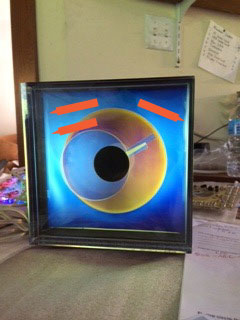
So here are the recommendations:
Get out your smart phone and send me pictures of the top, bottom, left, and right inside edges of the rear filter. Send to apclocks@gmail.com with a description of the problems you want fixed. Include your phone number and/or give Angie a call so you can discuss the pros and cons and how best to proceed. Angie's number is 707 694-7719.
Another factor in the decision.
Lastly, the original Prismas are easily damaged in shipping because they are very heavy, and the screws that hold the bottom on are so very, very small (2-56 for those of you who are technical). I recommend double boxing, with the front acrylic lens face down in the box. If they are in great shape insure the black case ones for $400 and the chrome case ones for $500.
The Prisma discussion ends here.
The SPECTRA, or BLACK HOLE by Kirsch-Hamilton: We repair the lights only (not the motor which uses plastic gears, sorry). If the motor fails take a look at our Prisma II. It uses a metal geared motor and is a much nicer and more repairable clock for the future.
SPECTRA
The lamps for these clocks are not commercially available any more. We have found substitutes but the lamp card must be modified for the new lamps to work. The modification plus the lamps is $49. A spare set of lamps is $21. Send in the lamp card from inside the clock. If you send the whole clock the charge is $65. Please include the check with the card. Thank you.
To remove the lamp card remove the 3 screws in the bottom and remove the bottom cover. Under the clover you will see a white nylon bar going across the lamp card slot. Remove one of the screws holding the nylon bar and loosen the other screw and swivel the lamp bar aside. You also we see red and white wires going into a white nylon connector. Pull on the white nylon connector to remove. Then hold the clock right side up and the lamp card will fall into your hand.
Also note that BIKRON is still in business, not making binary clocks anymore, at the same phone number 1-614-261-0454, but with a different name (R & D Group) and still at 1208 E. Hudson St., Columbus, OH, 43211. On rare occasions you will catch them in the right mood and they will do a repair, but most of the time you are out of luck.
We have on occasion helped repair these clocks, but it is expensive. It is a much better investment to purchase one of the Big Binary clocks. It is a lot more fun and includes power backup.
The Sondex by Kirsch Hamilton has similar circuitry to our AUDOCRON and we can frequently fix these also. Just give me a call.
That's all !!! We are not knowledgeable on other clocks!!!
General Repair Information
To send clocks no return authorization is required, but a good note describing the problem is essential for good service results. Include a couple of phone numbers and your email address so we can work around robo calls and really chat.
For the PRISMA, Model I, and AUDOCRON clocks phone before you send it. We may have some suggestions that will save you the trouble of sending it to us. Or, to save time, we can give you the choices and tell you how much money to send. Call Barry
ChronoArt Inc.
9175 Poplar Ave.
Cotati, CA 94931
Questions, call 707-795-1895, ask for Barry Gamble, M-F 8-5 PM Pacific Time, No Weekends Please.

